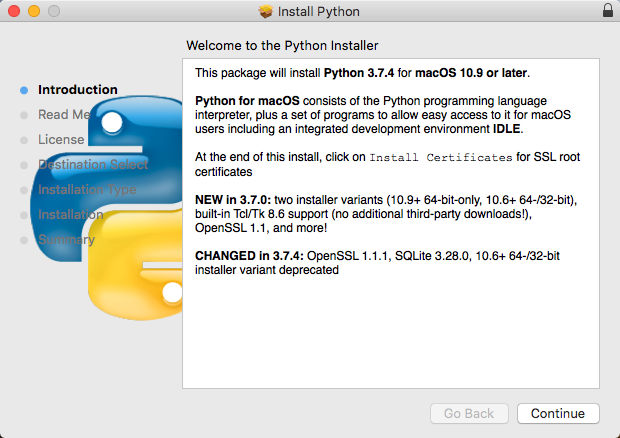Main development now takes place in the Python standard library: see the Python developer’s guide, and report issues on the Python bug tracker. However, if you find an issue specific to prior versions of Python (such as 2.7 or 3.2), you can post an issue on the BitBucket project page. 'Package manager' is a generic name for software to install, upgrade, and uninstall applications. Commands like dnf or apt on Linux, or pkgadd on BSD, or even pip on Python and luarocks on Lua, make it trivial for users to add new applications to their system. Once you've tried it, you're likely to find it hard to live without, and it's a convenience every operating system ought to include. Installing Python Image Library (PIL) This is an optional package but may be necessary depending on whether or not you use certain image sources (see the bluemarble example in BaseMaps). Again, no binary distribution is available for the Mac so you'll need to build from source. The ability to capture the text matched by glob patterns, and return those matches alongside the filenames. A recursive '.' globbing syntax, akin for example to the globstar option of the bash shell. The ability to replace the filesystem functions used, in order to glob on virtual filesystems. Compatible with Python 2 and Python 3 (tested with.
Getting started with JupyterLab
Install Glob For Python In Mac Download
The installation guide contains more detailed instructions
Installation with mamba or conda
Install Glob For Python In Mac Download
JupyterLab can be installed with mamba and conda:
or
Note: If you have not installed mamba or conda yet, you can get started with the miniforge distribution.
Installation with pip
If you use pip, you can install it with:
If installing using pip install --user, you must add the user-level bin directory to your PATH environment variable in order to launch jupyter lab. If you are using a Unix derivative (FreeBSD, GNU / Linux, OS X), you can achieve this by using export PATH='$HOME/.local/bin:$PATH' command.
Run JupyterLab
Once installed, launch JupyterLab with:
Getting started with the classic Jupyter Notebook
Installation with mamba or conda
The classic notebook can be installed with mamba and conda:
or
Installation with pip
If you use pip, you can install it with:
Congratulations, you have installed Jupyter Notebook! To run the notebook, run the following command at the Terminal (Mac/Linux) or Command Prompt (Windows):
See Running the Notebook for more details.
Getting started with Voilà
Installation with mamba or conda
If you use mamba or conda, you can install it with:

or
For more detailed instructions, consult the installation guide.
Installation with pip
If you use pip, you can install it with:
Getting started with JupyterLab
The installation guide contains more detailed instructions
Installation with mamba or conda
JupyterLab can be installed with mamba and conda:
or
Note: If you have not installed mamba or conda yet, you can get started with the miniforge distribution.
Installation with pip
If you use pip, you can install it with:
If installing using pip install --user, you must add the user-level bin directory to your PATH environment variable in order to launch jupyter lab. If you are using a Unix derivative (FreeBSD, GNU / Linux, OS X), you can achieve this by using export PATH='$HOME/.local/bin:$PATH' command.
Run JupyterLab
Once installed, launch JupyterLab with:
Getting started with the classic Jupyter Notebook
Installation with mamba or conda
The classic notebook can be installed with mamba and conda:
or

Installation with pip
If you use pip, you can install it with:
Congratulations, you have installed Jupyter Notebook! To run the notebook, run the following command at the Terminal (Mac/Linux) or Command Prompt (Windows):
See Running the Notebook for more details.

Getting started with Voilà
Installation with mamba or conda
If you use mamba or conda, you can install it with:
or
For more detailed instructions, consult the installation guide.
Installation with pip
If you use pip, you can install it with: